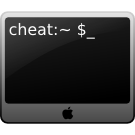Hints for Graphing
- gnuplot palettes
- Labeling Images
- Learning gnuplot
- Making graphs look good
- Making graphs readable
- Reading data from a file
- Three-dimensional data
gnuplot palettes
It can be helpful to use a defined color palette for three dimensional map plots. For example, if your data ranges from -2 to 2, you can make the positive and negative values, as well as zero, obvious by using a scale like this:
set palette defined (-2 "blue", 0 "white", 2 "green")
Labeling Images
Add label to southeast corner:
convert -font Verdana-Regular -pointsize 9 -background '#00000080' \ -fill lightblue label:'schutt.org' miff:- | composite -gravity southeast \ -geometry +0+0 - in.png out.png
Add text to bottom:
montage -geometry +0+0 -font Verdana-Regular -pointsize 9 \ -background 'gray(20%)' -fill skyblue \ -label "Some text goes here" in.png out.png
Learning gnuplot
The best introductions to gnuplot can be found at:
- /opt/local/share/doc/gnuplot/gnuplot.pdf
- gnuplot demos
- Not so FAQ
Making graphs look good
If you intend to display a graph on a webpage, the best format to use is PNG. Unfortunately, the gnuplot PNG terminal doesn't always produce the best looking graphs. You can often get better results by plotting with dimensions double the final size you want, then resampling the image. For example, if you want to make a graph 300x300 pixels with 9 point labels, plot at 600x600 with the font size set to 18. Then resize the image. An easy way to do this is with ImageMagick. My plot commands will look something like this:
set terminal png enhanced \ font "/Library/Fonts/Verdana.ttf" 18 \ size 2*300, 2*300 set output "plot.png" set title "Title Text" -2,0 font "/Library/Fonts/Verdana.ttf,22" set ylabel "Y label" 1.2,0 font "/Library/Fonts/Verdana.ttf,20" set xlabel "X label" font "/Library/Fonts/Verdana.ttf,20" plot "data.csv" using 1:2 with lines lc rgb "skyblue" lw 4 notitle;
Then I'll resize the plot from the command line (bash) using:
mogrify -geometry 50% myplot.png
or
convert -geometry 50% myplot.png myplot-small.png
The smoothing done when downsampling lowers apparent precision in addition to making the graph look better. This isn't really a problem, because if you need the precision, you will probably be linking the small plot to a larger version or the original data.
An alternative is to plot using the PostScript terminal, then convert to PNG. This has the advantage that you already have a PS file to link to.
Making graphs readable
Verdana is a good typeface for making small labels readable. If you have lots of text, Lucida Grande is a good choice.
Reading data from a file
I usually use gnuplot to plot data from a file, typically stored as a csv or tsv spreadsheet. gnuplot needs to be told which format to use:
set datafile separator ","for comma separatedset datafile separator "\t"for tab separated
For each plot command, you must tell gnuplot which data file to use. For example, to plot columns 5 and 6 vs column 1 in 'foo.csv' and column 2 vs 1 in 'bar.csv':
set datafile separator ","
plot 'foo.csv' using 1:5,\
'foo.csv' using 1:6,\
'bar.csv' using 1:2
If you are plotting multiple columns of data and some odd values are showing up, it may be due to missing data. In some cases you need to manually tell gnuplot what to do with missing data. For example, if missing points are simply left blank, use the command:
set datafile missing ""
Three-dimensional data
When graphing 3d data, it is often clearer to use a color map than to plot a surface in three dimensions. Use a clear color scale with an obvious mapping. This will make it easier to read. See 3-Dim Plot with a Color-Map (pm3d) for examples.
To plot something like this:
you can use these commands:
set terminal png size 600,600 crop # output a 600x600 pixel png image set pm3d map # use 3d color map plot set xrange [1:321] # manually set range of x-axis set yrange [1:321] set size square # make the plot square unset key # don't show key set format x '' # don't show axis label set format y '' set cbrange [0:25] # the range of the z data set output 'out.png' # the output file name set title 'the title' # graph title splot 'data.out' using 1:2:3 # plot the data file using the first three columns
